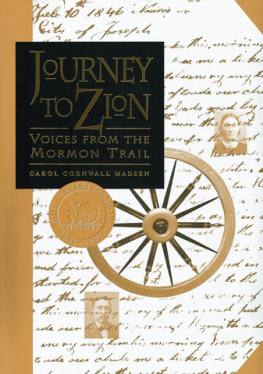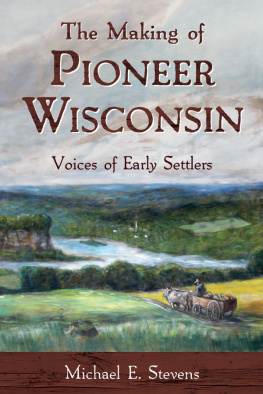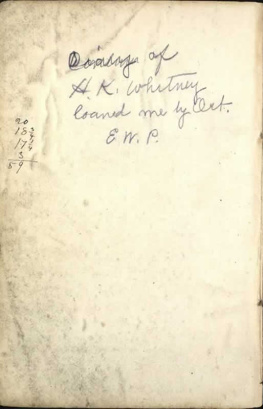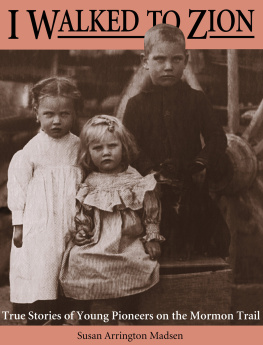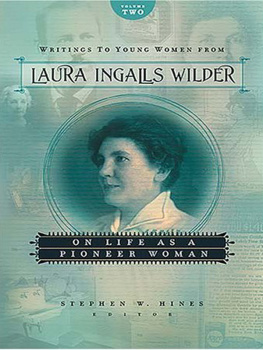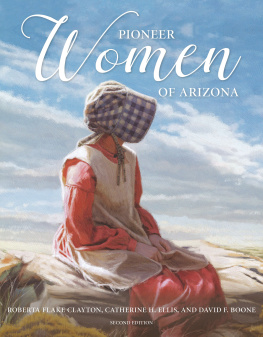Journey to Zion: Voices from the Mormon Trail
Carol Cornwall Madsen
1997 Deseret Book CompanyAll rights reserved. No part of this book may be reproduced in any form or by any means without permission in writing from the publisher, Deseret Book Company, P.O. Box 30178, Salt Lake City, Utah 84130. This work is not an official publication of The Church of Jesus Christ of Latter-day Saints. The views expressed herein are the responsibility of the author and do not necessarily represent the position of the Church or of Deseret Book Company.Deseret Book is a registered trademark of Deseret Book Company.
FOREWORD
For more than a century, historians of the American West have lauded Brigham Young's accomplishments in leading the Latter-day Saints to the Salt Lake Valley and in expanding Mormon settlement across a broad western landscape. From the perspective of western settlement history, two observations commonly emerge in telling the story of the westward trek and subsequent colonization of the Intermountain West. First, historians note that The Church of Jesus Christ of Latter-day Saints succeeded in moving tens of thousands of emigrants west during a twenty-year pioneering period because of the organizing skills of President Young. Second, they note the importance of the unity of the Saintstheir commitment to a common purpose and their willingness to sacrifice personal needs for the greater good.
Both of these characteristics were evident in the Church long before the Saints sold their farms and homes in the Nauvoo area and elsewhere and fitted out for a journey into the wilderness beyond United States boundaries. Brigham Young and others had experienced the benefits of traveling in well-organized migrant companies. They had marched under military style in Zion's Camp from Kirtland, Ohio, to Clay County, Missouri, under the leadership of the Prophet Joseph Smith in 1834. Many of the Saints migrated to Missouri in organized companies. Members of the Quorum of the Twelve helped organize the removal of the Saints from Missouri to a new place of refuge in the Nauvoo area. They did so by creating a committee to manage resources and people. In addition, during their mission in England, the Twelve structured the Saints into branches and districts with spiritual overseers and regular procedures for reporting.
These experiences taught the Twelve that, like the biblical children of Israel, the Lord's modern people were willing to follow their leaders because of testimonies that bound them to a common objective. The Saints who gathered to the designated Zion across the Rocky Mountains during the last half of the nineteenth century believed that the Lord had picked that place for refuge. In every step they took, the Saints moved westward with faith. They longed to gather with other believers, and they looked forward to the opportunity to build a temple to replace the Houses of the Lord left behind in Kirtland and Nauvoo.
The word and will of the Lord to Brigham Young, given in Iowa in January 1847, confirmed the use of principles tried and tested over a dozen years by faithful members. The Saints understood and accepted the organizational pattern set forth by the Lord: "Let the companies be organized with captains of hundreds, captains of fifties, and captains of tens, with a president and his two counselors at their head, under the direction of the Twelve Apostles" (D&C 136:3). The carefully structured emigrant camps offered inexperienced travelers the safety that comes from sharing talents and resources. It allowed the Saints to cooperate in establishing Zion and fulfilling its purposes of gathering believers to temple cities, offering them saving ordinances, and performing those same ordinances by proxy for deceased ancestors.
Brigham Young's inspired guidelines for the westward trek emphasized that organization, orderliness, cooperation, and discipline on the trail encompassed spiritual as well as temporal principles. Latter-day Saint emigrants were "organized into companies, with a covenant and promise to keep all the commandments and statutes of the Lord" and to "walk in all the ordinances of the Lord." If the Saints would share their goods with the poor, the widows, and the fatherless "with a pure heart, in all faithfulness," the Lord promised to bless them in their journey to "a land of peace" (D&C 136:2, 4, 8, 11, 16).
Here, then, is the key to understanding the individual experiences of pioneering. Each diary kept, letter written, and reminiscence penned carries within it the seeds of faith. The westering Saints were preparing a people to receive the risen Lord when he returned to claim his people. They emulated in their lives the Christian principles of faith, charity, and hope. They sought the blessings of eternal life in temples, and they wanted their ancestors and their children to enjoy the same blessings. The organized migration was a means to a faith-filled objective.
In the fine collection of personal documents assembled by Carol Cornwall Madsen in this volume, the generation that pioneered a western headquarters for the Church through their personal sacrifices preserved a message for later generations. As a worldwide church remembers their faith in a time of commemoration, that message of faith carries new meaning. Those early Saints accepted the Lord's reminder: "My people must be tried in all things, that they may be prepared to receive the glory that I have for them, even the glory of Zion; and he that will not bear chastisement is not worthy of my kingdom." That promised glory would be theirs, the Lord explainedin words just as true today"if ye are faithful in keeping all my words that I have given you, from the days of Adam to Abraham, from Abraham to Moses, from Moses to Jesus and his apostles, and from Jesus and his apostles to Joseph Smith, whom I did call upon by mine angels, my ministering servants, and by mine own voice out of the heavens, to bring forth my work; which foundation he did lay, and was faithful" (D&C 136:31, 37-38).
The first generation of Latter-day Saints set in motion the Lord's work of bringing his church out of obscurity (see D&C 1:30). When Mary Fielding Smith, the wife of Hyrum Smith, left her husband incarcerated at Liberty Jail in 1838 and set out from Far West, Missouri, to find a new place of refuge in Illinois, she understood these same principles. To her brother in England, she wrote, "I feel but little concerned about where I am, if I can but keep my mind staid upon God; for, you know in this there is perfect peace" (Millennial Star 2 [June 1840]: 41).
Glen M. Leonard
PREFACE
This volume represents the contributions of many people. An invitation from Sheri Dew of Deseret Book to make a collection of Mormon trail diaries and reminiscences for the 1997 Sesquicentennial Celebration initiated the project. The cooperation of Richard Turley, William Slaughter, Linda Haslam, and other staff members of the LDS Church Archives greatly facilitated locating the documents. The excellent research assistance of Joe Richardson, Rex Griffiths, Marianne Griffiths, and Sheri Slaughter in Salt Lake City, and Brigham Young University students Becky Dodds and Kimberly Dray, helped enormously in the selection and preparation of the accounts. Special thanks go to research assistants Kami Wilson and Rebecca Hopkins, who gave enthusiastic and meticulous service in the final preparation of this volume. Typists Marlise Paxman and Sariah Wilson were essential contributors. I am also indebted to my colleagues at the Joseph Fielding Smith Institute for Church History for their support, especially our director, Ronald E. Esplin; William G. Hartley, and expert on the Iowa trail; and Marilyn Parks, our secretary, whose assistance and advice were invaluable.

